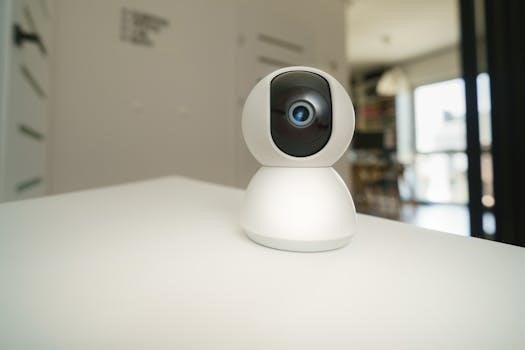
Welcome to your comprehensive guide for Honeywell home security systems! This manual provides an overview of various Honeywell security solutions, from basic to advanced systems․ Here you will find information to help you understand, operate, and maintain your Honeywell system effectively․ We are here to assist you in maximizing the security of your home․
Honeywell offers a wide array of home security systems designed to provide comprehensive protection for your residence․ These systems range from basic intrusion detection to advanced, integrated solutions featuring smart home capabilities․ Honeywell’s commitment to security is evident in their diverse product line, which caters to various needs and budgets, ensuring that every homeowner can find a suitable system․ Their systems often incorporate features like door and window sensors, motion detectors, and alarm keypads, which can be customized to fit the specific layout and requirements of your home․
With a focus on reliability and ease of use, Honeywell security systems aim to offer peace of mind through robust performance and user-friendly interfaces․ Many systems are compatible with mobile applications, allowing for remote arming, disarming, and monitoring of your home’s security․ Whether you’re looking for a simple system to safeguard your family or a more complex solution that integrates with smart home devices, Honeywell has a range of products to meet your security goals․ This introduction will guide you through the various components and functionalities you can expect from your Honeywell system․

Understanding Your Honeywell System Components
A typical Honeywell home security system comprises several key components working together to safeguard your property․ The central control panel serves as the brain of the system, managing all connected devices and communicating with monitoring services, if applicable․ Keypads are essential for arming and disarming the system, often featuring a user-friendly interface for easy operation․ Door and window sensors are crucial for detecting unauthorized entry, triggering an alarm when a protected door or window is opened while the system is armed․
Motion detectors play a significant role in detecting movement within your home, adding an extra layer of security․ Some systems also include environmental sensors, such as smoke and carbon monoxide detectors, for comprehensive protection․ Wireless devices, such as key fobs and remote controls, offer convenient control of the system․ Depending on your specific Honeywell system, you may also have access to interactive features through a mobile application, allowing for remote monitoring and control․ Familiarizing yourself with these components will enable you to use your system effectively and ensure the best possible protection for your home․
Honeywell Lynx Touch Series Manuals (L5200, L5100, L5000)
The Honeywell Lynx Touch series, encompassing models L5200, L5100, and L5000, represents a line of advanced all-in-one security systems known for their intuitive touchscreen interfaces and comprehensive features․ Each model offers robust protection and seamless integration of various security components․ The Lynx Touch L5200, for example, is celebrated for its enhanced connectivity options and expanded capabilities․ Similarly, the L5100 is a popular choice due to its user-friendly design and reliable performance․ The L5000, being an earlier model, still provides excellent security features and is a testament to Honeywell’s quality․
User manuals for these systems are crucial for understanding their specific functionalities, including arming and disarming procedures, programming options, and troubleshooting steps․ The manuals provide detailed instructions for navigating the touchscreen interface, setting up user codes, configuring sensors, and utilizing the system’s interactive features․ These manuals are typically available for download online and are an essential resource for maximizing the potential of your Honeywell Lynx Touch system․ If you are looking for a specific manual, be sure to check the official Honeywell website or authorized dealer sites․
Honeywell Vista Series Manuals (15P, 20P, 21IP)
The Honeywell Vista series, including models 15P, 20P, and 21IP, represents a robust line of security systems designed for both residential and commercial applications․ These systems are known for their reliability and versatility, offering a wide range of features to meet diverse security needs․ The Vista 15P is a popular choice for smaller homes, providing a solid foundation for intrusion detection․ The Vista 20P expands on this, offering greater capacity for zones and additional features, making it suitable for larger homes and small businesses․ The Vista 21IP, with its integrated IP communication, is designed for advanced security needs, providing seamless connectivity for remote monitoring and control․
User manuals for the Vista series are essential for proper installation, programming, and operation․ These manuals provide detailed instructions on connecting sensors, setting up user codes, arming and disarming the system, and troubleshooting common issues․ They often include wiring diagrams, programming menus, and step-by-step guides to ensure users can effectively manage their security system․ Accessing these manuals online, typically through the Honeywell website or authorized dealer portals, is crucial for maximizing the performance and longevity of your Vista system․ Proper understanding of these manuals is vital for maintaining the integrity of your security setup․
Arming and Disarming Your Honeywell System
Effectively arming and disarming your Honeywell security system is fundamental to its operation․ Arming the system activates the sensors, ensuring that any intrusion triggers an alarm․ There are typically two primary arming modes⁚ “Away” and “Stay․” “Away” mode is used when no one is present on the premises, activating all sensors including motion detectors․ “Stay” mode is designed for when you are inside the home, deactivating interior motion sensors while keeping perimeter sensors active․ Understanding the differences between these modes is critical for avoiding false alarms and maintaining proper security coverage․
Disarming the system requires the use of a valid user code or key fob․ Typically, the process involves entering your code on the keypad or using a designated button on your key fob․ The system will then acknowledge the disarming action․ It’s crucial to understand the system’s response, such as a beep or a display message, to confirm proper disarming․ Familiarizing yourself with your specific system’s arming and disarming procedures is vital for efficient use․ Always ensure that all occupants are aware of the necessary codes and procedures to prevent any confusion or accidental alarms․ Regularly practicing arming and disarming will enhance your proficiency and confidence in using your Honeywell security system․
Using the Honeywell Keypad Effectively

The Honeywell keypad is the primary interface for interacting with your security system․ Understanding its functions and features is crucial for effective operation․ Keypads vary across different Honeywell models, but they generally include a numeric keypad for entering codes, function keys for arming and disarming, and an LCD screen that displays system status and prompts․ Familiarize yourself with the layout and the purpose of each button to ensure smooth operation․
Effective keypad use also involves understanding the feedback provided by the system, such as beeps indicating successful commands, error messages, and system status updates․ Learning to interpret these signals will make troubleshooting easier․ Be aware of the keypad’s backlighting features, which can aid in visibility under various lighting conditions․ Many keypads also have features like panic buttons for emergencies․ Regular cleaning of the keypad ensures proper responsiveness․ Understanding menu navigation is vital for customizing settings and accessing advanced options․ Practicing using the keypad will make you more comfortable and efficient in managing your system․ Remember, the keypad is your gateway to controlling your security system, so mastering it is essential․

Honeywell Total Connect 2․0 Guide and Features
Honeywell Total Connect 2․0 is a powerful platform that allows users to remotely manage and monitor their security system through a smartphone, tablet, or computer․ This guide will help you navigate the key features of Total Connect 2․0․ This service enhances security by providing real-time alerts, remote arming/disarming, and the ability to view live video feeds from connected cameras․ Setting up your account involves registering your system and downloading the app․
Explore features like event notifications, user management, and scene creation for customized automation․ Total Connect 2․0 lets you create personalized scenes that automate multiple actions, such as arming the system and adjusting smart devices․ The platform provides access to your system’s history and logs, allowing you to review past activity․ Learn to set up notifications for various triggers, such as alarm events or system status changes․ Understanding how to add and manage users allows you to grant different access levels to family members or trusted individuals․ The platform’s intuitive interface simplifies system control, providing peace of mind and enhanced security․ Regular updates and maintenance ensure the app remains efficient and secure․ Mastering Total Connect 2․0 gives you greater control over your home security․
DIY Installation and Programming Guide
This section provides a detailed guide for installing and programming your Honeywell security system yourself․ This DIY approach can save costs and provide a deeper understanding of your system’s functionality․ Begin by carefully planning your system layout, considering the placement of sensors, control panels, and keypads․ This guide will walk you through the unboxing and mounting process, ensuring all components are correctly installed․ Follow each step carefully, consulting the specific manual for your Honeywell model for specific instructions․
Programming your system involves setting up zones, user codes, and communication settings․ This section outlines how to navigate the system’s programming menus and configure these essential parameters․ You will learn how to enroll sensors, set entry/exit delays, and test the system to ensure everything works as expected․ Be sure to consult your specific model manual for detailed instructions and compatibility information․ Setting up wireless connections and testing communication signals are also crucial steps detailed in this guide․ Troubleshooting tips are included to help resolve common issues that may arise during installation and programming․ This DIY guide is designed to give you confidence in setting up your Honeywell system․
Troubleshooting Common Issues
This section addresses common problems users may encounter with their Honeywell security systems, providing practical solutions to keep your system running smoothly․ One frequent issue is sensor malfunction, which can often be resolved by checking battery levels or ensuring proper alignment․ Error codes displayed on your keypad are also explained here, helping you identify specific problems and take appropriate action․ If your system is experiencing communication failures, this guide offers steps to check network connections or contact your monitoring provider․
False alarms can be disruptive, and this section provides tips on how to minimize them․ Learn how to adjust sensor sensitivity and properly close doors and windows․ If you have issues arming or disarming your system, this section outlines steps to verify user codes or bypass malfunctioning sensors․ This guide also covers how to address power outages or low battery issues, which are common causes of system interruptions․ We also discuss issues related to Total Connect 2․0, such as connectivity problems or app errors․ By using the troubleshooting steps provided, you can effectively diagnose and resolve many issues without needing to contact technical support․ Remember to consult your specific Honeywell model’s manual for further details and more personalized help․
Honeywell Security System Compatibility
Understanding the compatibility of your Honeywell security system is crucial for seamless integration and optimal performance․ This section outlines the various devices and accessories that are compatible with Honeywell systems, ensuring you select the right components for your needs․ We delve into the compatibility of different sensors, including motion detectors, door/window sensors, and environmental sensors, with various Honeywell control panels like the Vista series and Lynx Touch series․ It is important to verify that any additional devices are approved by Resideo Technologies, Inc․ to ensure compatibility․
This section also addresses compatibility with smart home platforms and integrations, explaining how Honeywell systems can connect with popular smart devices․ We cover the compatibility of Total Connect 2․0 with different devices and operating systems, making it easier to manage your system remotely․ Furthermore, we discuss the compatibility of various keypads and user interfaces with Honeywell systems, explaining how to ensure proper functionality․ It is important to note that some older Honeywell models may have limitations, and this guide helps you navigate those constraints․ This section also touches upon compatibility with professional monitoring services and how to ensure your system can effectively communicate with central stations․ By understanding the compatibility guidelines, you can avoid integration issues and maximize the effectiveness of your security system․
Maintenance and Care of Your System
Proper maintenance and care are essential to ensure the longevity and reliability of your Honeywell home security system․ This section provides guidelines on how to keep your system in optimal working condition․ Regular checks of all sensors, including door/window sensors and motion detectors, are recommended to ensure they are functioning correctly․ Cleaning these sensors with a soft, dry cloth will remove any dust or debris that may interfere with their operation․ Battery replacement is another crucial aspect of maintenance, and this guide provides information on how to identify when batteries need replacement and how to replace them properly․
Additionally, this section discusses the importance of regularly testing your system, which includes arming and disarming to verify all components are functioning as expected․ We provide specific steps on how to perform these tests effectively․ Furthermore, we offer guidance on keeping your system’s software up to date, as firmware updates can improve system performance and address any known issues․ This section also covers preventative measures to avoid common issues, such as protecting your system from extreme temperatures and keeping the control panel accessible for easy maintenance․ Proper care also means keeping the user manual accessible for quick reference․ By adhering to these maintenance guidelines, you can ensure your Honeywell security system provides reliable protection for years to come․
Contacting Honeywell Support and Finding Manuals
If you encounter any issues with your Honeywell home security system or need further assistance, this section provides guidance on how to contact Honeywell support and locate relevant manuals․ Honeywell offers various channels for customer support, including phone support, email, and online resources․ We will provide you with the most up-to-date contact information for the technical support team to ensure you receive prompt and efficient help․ Furthermore, this section details how to navigate the Honeywell website to find the specific user manuals for your system model․ Accessing the correct manual is vital for understanding your system’s features and troubleshooting any problems․
We also provide information on other resources, such as online forums and communities where you can find answers to frequently asked questions and connect with other Honeywell users․ This section will explain how to use search features on the Honeywell website to quickly locate documents, firmware updates, and other support materials․ Additionally, we include tips on how to prepare for your support call, such as having your system model number and specific issue ready․ By having access to the right resources, you can quickly get the help you need and resolve any problems efficiently․